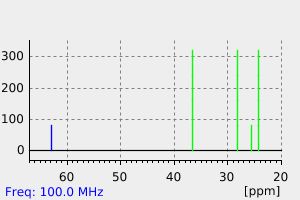氯环辛烷 | 1556-08-7
中文名称
氯环辛烷
中文别名
——
英文名称
cyclooctyl chloride
英文别名
chlorocyclooctane;Chlor-cyclooctan;1-chlorocyclooctane
CAS
1556-08-7
化学式
C8H15Cl
mdl
——
分子量
146.66
InChiKey
LDOZEEFSUYHNPM-UHFFFAOYSA-N
BEILSTEIN
——
EINECS
——
-
物化性质
-
计算性质
-
ADMET
-
安全信息
-
SDS
-
制备方法与用途
-
上下游信息
-
文献信息
-
表征谱图
-
同类化合物
-
相关功能分类
-
相关结构分类
物化性质
-
沸点:85-86 °C(Press: 21 Torr)
-
密度:0.95±0.1 g/cm3(Predicted)
-
保留指数:1197
计算性质
-
辛醇/水分配系数(LogP):2.9
-
重原子数:9
-
可旋转键数:0
-
环数:1.0
-
sp3杂化的碳原子比例:1.0
-
拓扑面积:0
-
氢给体数:0
-
氢受体数:0
安全信息
-
海关编码:2903890090
SDS
反应信息
-
作为反应物:描述:参考文献:名称:Taskinen,E., Acta chemica Scandinavica. Series B: Organic chemistry and biochemistry, 1974, vol. B 28, p. 357 - 366摘要:DOI:
-
作为产物:参考文献:名称:在可见光和Ag @ AgX的共同催化下,未活化的C(sp 3)–H与NaX的高度选择性卤化摘要:未活化C(sp 3的直接选择性卤化)–在室温下,在可见光或LED辐射下,在空气中存在NaX / HX水溶液作为卤化物源的情况下,使用纳米Ag / AgCl催化剂在室温下将H键转变为C-卤素键。烃的卤化为单卤化物取代的产物提供了95%的选择性,收率高于90%,甲苯的氯化率为81%,远高于使用二氯的40%转化率。机理研究表明,该反应是使用蓝光(450-500 nm)的自由基过程,可见光是最有效的光源。提出了辐照以引起AgCl键合电子被激发并且来自氯离子的电子转移引起氯自由基的形成,其驱动取代反应。DOI:10.1039/c8gc02628a
文献信息
-
An efficient method for chlorination of alcohols using PPh3/Cl3CCONH2作者:Wanchai Pluempanupat、Warinthorn ChavasiriDOI:10.1016/j.tetlet.2006.07.060日期:2006.9A new and convenient method for the chlorination of alcohols utilizing PPh3/Cl3CCONH2 is addressed. Various alcohols could smoothly be converted into their corresponding alkyl chlorides in high yield under mild conditions with short reaction times. A mechanism is disclosed with the evidence of inversion of configuration of the analogous alkyl chloride derived from R-(−)-2-octanol.
-
New alkane functionalization reactions based on gif-type chemistry in the presence of alkali metal salts.作者:Derek H.R. Barton、Stéphane D. Bévière、Warinthorn Chavasiri、Darío Doller、Bin HuDOI:10.1016/s0040-4039(00)91950-6日期:1993.3Cycloalkanes are transformed into monosubstituted cycloalkyl derivatives (chloride, azide, cyanide, thiocyanate, dicycloalkyl disulfide, or nitroalkane
-
Metal-free regioselective hydrochlorination of unactivated alkenes<i>via</i>a combined acid catalytic system
-
Catalytic process for regiospecific chlorination of alkanes, alkenes and arenes申请人:Council of Scientific and Industrial Research公开号:US06825383B1公开(公告)日:2004-11-30The present invention provides a process for regiospecific chlorination of an aromatic or aliphatic compound with a chlorine source comprising a metal chloride and other than Cl2 and SO2Cl2 in presence of hypervalent iodine catalyst and in acidic medium.
-
Catalytic Bromination of Alkyl sp<sup>3</sup>C–H Bonds with KBr/Air under Visible Light作者:Mengdi Zhao、Wenjun LuDOI:10.1021/acs.orglett.8b02208日期:2018.9.7Alkyl sp3C–H bonds of cycloalkanes and functional branch/linear alkanes have been successfully brominated with KBr using air or O2 as an oxidant at room temperature to 40 °C. The reactions are carried out in the presence of catalytic NaNO2 in 37% HCl (aq)/solvent under visible light, combining aerobic oxidations and photochemical radical processes. For various alkane substrates, CF3CH2OH, CHCl3, or CH2Cl2
表征谱图
-
氢谱1HNMR
-
质谱MS
-
碳谱13CNMR
-
红外IR
-
拉曼Raman
-
峰位数据
-
峰位匹配
-
表征信息
同类化合物
顺式1,4-二氯-2-甲基-2-丁烯
顺式1,1,1,5-四氯-4-甲基-3-戊烯
顺式-7-甲基环庚-2-烯基氯
顺式-4-甲基环庚-2-烯基氯
顺式-1-氨基-4-氯-2-丁烯
顺式-1,4-二氯-2-丁烯
顺-6-氯-2-己烯
顺-4-氯-2-丁烯胺盐酸盐
锡烷,二(4-氯丁基)羰基-
锡烷,三氯(2-乙烯基壬基)-
重氮乙酰氯
辛基癸基二甲基氯化铵
聚乙烯胺
羟肟基乙酰氯
磷亚胺三氯化,[1,2,2,2-四氯-1-(三氯甲基)乙基]-
硫代氯甲酸-O-辛酯
癸醛,2,2-二氯-
甲醛与氨和氯乙烷的聚合物
甲基(2E)-2-(3-氯-2-丁烷亚基)肼羧酸酯
环己烷,(氯甲基)-
环丙烷,2-丁基-1-氯-1-(1-戊炔基)-,顺-
环丙烷,1,2-二溴-3,3-二氯-1,2-二丙基-,反-
环丙烷,1,1-二溴-2,3-二氯-2,3-二乙基-,反-
环丙烷,1,1-二氯-3-(氯甲基)-2,2-二甲基-
环丙烷,1,1,2,3-四氯-2,3-二甲基-,反-
环丙基甲基氯
环丁基氯
特比萘芬杂质17
溴代二氯丁烷
油酰氯
油酰氯
水合2-氯乙醛
氯螺戊烷
氯磺酸-(2,3-二氯丙酯)
氯甲醇
氯甲氧基
氯甲基自由基
氯甲基环丁烷
氯甲基氯磺酸酯
氯甲基二氯甲基醚
氯甲基(甲基)次磷酰氯
氯环辛烷
氯环癸烷
氯环庚烷
氯环丙烷
氯十七烷
氯化链烷烃
氯化环十二烷
氯化新戊烷
氯代环戊烷







